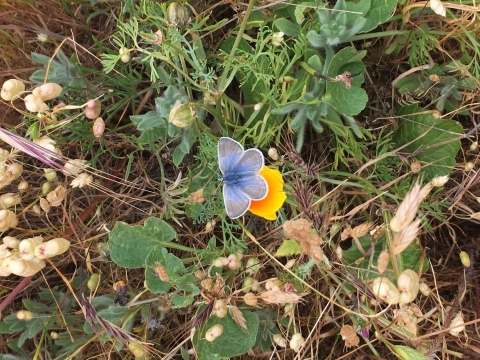Growing up between Davis and Winters, California, Samantha Lantz raised goats and horses. She also collected monarch caterpillars every year and raised them until they became butterflies. “I think my interest in animals sparked my interest in biology,” she said.
It was an interest that turned into a career. Today, Lantz, who goes by Sam, is a biologist for the U.S. Fish and Wildlife Service’s Sacramento Field Office. She works in the Recovery Division reviewing the latest science available on threatened and endangered species and drafting reports that include strategies for helping their wild populations recover.
The Service wasn’t Lantz’s first stop in conservation. Her undergraduate work at Willamette University in Oregon led her to pursue a master’s at Florida Atlantic University where she studied habitat restoration in the Everglades. She then pursued her Ph.D. in bird behavior at Tulane.
Her research for her Ph.D. led her to Australia where she studied fairywrens, a tiny bird that’s common throughout the country. Male fairywrens are very colorful during breeding season and transition into duller plumage during non-breeding season. Lantz captured male fairywrens, and by measuring color levels in their feathers throughout the year, learned that males renew and even enhance the color in their feathers throughout the breeding season to attract a mate. Her research is among the first to document this process, known as adventitious molt, in fairywrens and its impact in mate selection.
Throughout her studies, she gained experience in several wildlife biology research methods, including radio tracking, hormone sampling and genetics. “Ten years ago, I was taking tiny blood samples to look at genetics in birds,” Lantz recalled. “The amount of information you can get today from the same type of sample has grown exponentially. It’s amazing how far the field has come.”
Lantz’s interest in animal genetics carried over into her work at the Service, and she’s optimistic about the progress being made on several listed species.
“With genetic information specific to the species, you can get a better sense for where there are bottlenecks in populations and where there are opportunities to bring in more genetic diversity,” she said.
Genetic diversity is important to have in species populations as it enables species to adapt to changing environmental conditions.
For example, genetic information collected and analyzed by the United States Geological Survey on endangered blunt-nosed leopard lizards found in the Central Valley shows historical connectivity in populations have been fragmented over the years by roads and development. This gives biologists like Lantz ideas on how partners can work together to protect or restore land to improve the genetic diversity of the species. Habitat acquisition and restoration efforts that restore connectivity between populations and improve recovery of the species are currently underway in the San Joaquin Valley by the Bureau of Land Management and other partners.
“The Service’s efforts with partners on recovery actions gives me hope for the future of these species,” she said.
Her work at the Service has brought her back to her childhood love for butterflies. Earlier this year, Lantz completed updates to the recovery plans for the Mission blue butterfly and San Bruno elfin. Both are species unique to the Bay Area and can only be found on or near San Bruno Mountain. In her position, Lantz finds the latest science papers on species and creates well-informed guidance documents that include the best science available.
While most of her work is done at her desk in the Sacramento office, she still gets out into the field when possible.
“Coming from being a field biologist, getting out into the field is an incredibly important part of learning about species, their needs and their habitat.”
Earlier this year, Lantz assisted with translocating endangered Mission blue butterflies from San Bruno Mountain to Milagra Ridge in the Golden Gate National Recreation Area. The Mission blue butterfly population at Milagra Ridge experienced sharp declines in recent years partly due to a fungus that kills one of the lupine species that the butterfly uses as a host plant. Adults lay eggs on the lupine, which then serves as the sole source of food for the caterpillars. During the visit, Lantz saw eggs on lupine, which is a positive sign for the translocation project.
She was joined by biologists from the National Park Service, Golden Gate National Parks Conservancy and San Mateo County Parks. These partners manage and protect the habitat occupied by the Mission blue butterfly and are successfully contributing to its recovery.
“Recovery is not about saving one species. It requires looking at the entire ecosystem. It’s really inspiring to see people fighting for these species and their habitat,” said Lantz
As for what’s next on Lantz’s to do list, she doesn’t quite know what species she’ll be analyzing next.
Although her background is mostly working with birds, she said, “I definitely have a soft spot for butterflies.”






